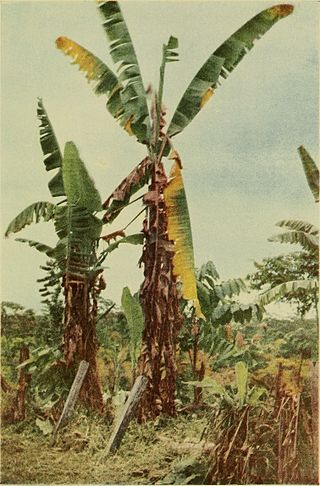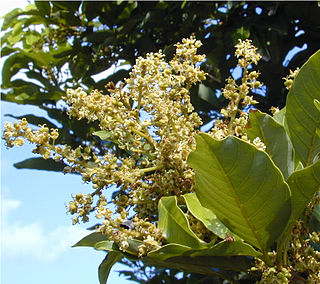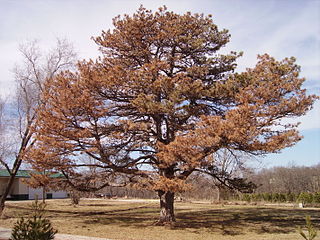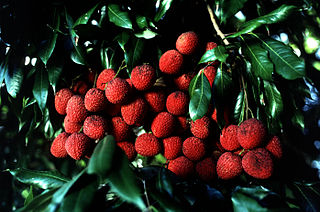
A mango is an edible stone fruit produced by the tropical tree Mangifera indica. It is believed to have originated in southern Asia, particularly in eastern India, Bangladesh, and the Andaman Islands. M. indica has been cultivated in South and Southeast Asia since ancient times resulting in two types of modern mango cultivars: the "Indian type" and the "Southeast Asian type". Other species in the genus Mangifera also produce edible fruits that are also called "mangoes", the majority of which are found in the Malesian ecoregion.

Rambutan is a medium-sized tropical tree in the family Sapindaceae. The name also refers to the edible fruit produced by this tree. The rambutan is native to Southeast Asia. It is closely related to several other edible tropical fruits, including the lychee, longan, pulasan, and quenepa.

Dimocarpus longan, commonly known as the longan and dragon's eye, is a tropical tree species that produces edible fruit. It is one of the better-known tropical members of the soapberry family Sapindaceae, to which the lychee and rambutan also belong. The fruit of the longan is similar to that of the lychee, but less aromatic in taste. It is native to tropical Asia and China.

Fusarium wilt is a common vascular wilt fungal disease, exhibiting symptoms similar to Verticillium wilt. This disease has been investigated extensively since the early years of this century. The pathogen that causes Fusarium wilt is Fusarium oxysporum. The species is further divided into formae speciales based on host plant.

Panama disease is a plant disease that infects banana plants. It is a wilting disease caused by the fungus Fusarium oxysporum f. sp. cubense (Foc). The pathogen is resistant to fungicides and its control is limited to phytosanitary measures.

Nephelium is a genus of about 25 species of flowering plants in the family Sapindaceae, native to southeastern Asia.

Nephelium ramboutan-ake, the pulasan, is a tropical fruit in the soapberry family Sapindaceae. It is closely related to the rambutan and sometimes confused with it. Other related soapberry family fruits include lychee and longan. Usually eaten fresh, it is sweeter than the rambutan and lychee, but very rare outside Southeast Asia.
Gibberella xylarioides is a species of fungus in the family Nectriaceae. It is the causative agent of coffee wilt disease (CWD). The disease caused a severe problem in several countries in West and East Africa during the 1940s and 1950s. CWD was first seen in Coffea liberica.
Ceratocystis paradoxa or Black Rot of Pineapple is a plant pathogen that is a fungus, part of the phylum Ascomycota. It is characterized as the teleomorph or sexual reproduction stage of infection. This stage contains ascocarps, or sacs/fruiting bodies, which contain the sexually produced inoculating ascospores. These are the structures which are used primarily to survive long periods of time or overwinter to prepare for the next growing season of its host. Unfortunately, the sexual stage is not often seen in the natural field but instead the anamorph, or asexual stage is more commonly seen. This asexual stage name is Thielaviopsis paradoxa and is the common cause of Black rot or stem-end rot of its hosts.

Mangifera indica, commonly known as mango, is a species of flowering plant in the family Anacardiaceae. It is a large fruit tree, capable of growing to a height of 30 metres. There are two distinct genetic populations in modern mangoes – the "Indian type" and the "Southeast Asian type".

A wilt disease is any number of diseases that affect the vascular system of plants. Attacks by fungi, bacteria, and nematodes can cause rapid killing of plants, large tree branches or even entire trees.
Archips micaceana is a moth of the family Tortricidae. It is found in China, Hong Kong, southern Vietnam, Burma, and northern Thailand. It is a minor pest of many agricultural crops.

Fusarium mangiferae is a fungal plant pathogen that infects mango trees. Its aerial mycelium is white and floccose. Conidiophores on aerial mycelium originating erect and prostrate from substrate; they are sympodially branched bearing mono and polyphialides. Polyphialides have 2–5 conidiogenous openings. Phialides on the aerial conidiophores mono- and polyphialidic. Sterile hyphae are absent. Microconidia are variable in shape, obovoid conidia are the most abundant type, oval to allantoid conidia occurring occasionally. Microconidia mostly 0-septate with 1-septate conidia occurring less abundantly. Sporodochia are present. Macroconidia are long and slender, usually 3–5 septate. Chlamydospores are absent.
Velvet blight is a disease that affects the stems, branches, leaves, fruits or trunks of plants and trees. This disease is primarily caused by three fungal species from the genus Septobasidium: S. bogoriense, S. pilosum and S. theae.
Homona eductana is a species of moth of the family Tortricidae. It is found in India, Thailand, Malaysia, Singapore and China.

Hypomeces pulviger, also known as the gold-dust weevil or green weevil, is a species of beetle in the true weevil family. The adult weevil can reach a length of about 14 mm (0.6 in) and is covered with iridescent green or yellowish-green dust-like scales all over the body. This species can be found in India, tropical Southeast Asia, and the Philippines. Both the larvae and adults are crop pests. The larvae live in and pupate in the soil, feeding on living plant roots. The adult weevils are long-lived, doing damage to foliage, and sometimes defoliating young bushes and nursery trees.

Longan witches broom-associated virus is a species of positive-sense single-stranded RNA virus that has not been assigned to a genus within the family Potyviridae. It is thought to be the cause of witch's broom in longan, a large tropical tree from southeastern Asia of economic value. Longan witches broom disease is a condition that was first described in 1941. The virus was found in symptomatic plants and absent in healthy plants, but not all of Koch's postulates have been fulfilled.

Lancetilla Botanical Garden is a botanical garden and significant tourist attraction located on the coast of the Caribbean Sea, in the north of the Republic of Honduras, about 7 km southeast of the city of Tela.

Cryphalus mangiferae, the mango bark beetle, is a tiny tropical bark beetle which attacks mango trees. It is often cited as a vector of plant pathogenic fungi infecting mango trees. The species belongs to the family Curculionidae, subfamily Scolytinae.













